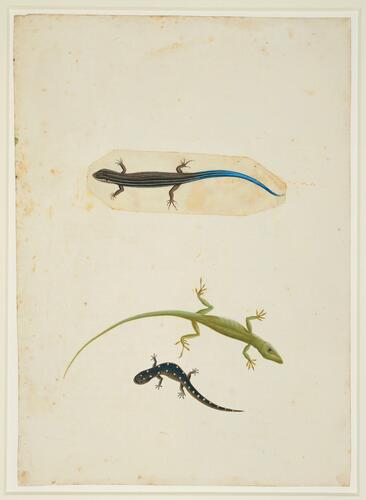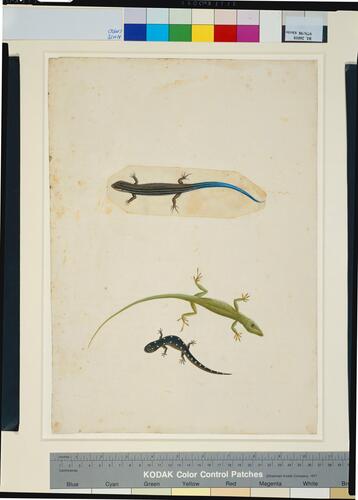-
1 of 253523 objects
Mark Catesby (1682-1749)
The Blue-tail Lizard, the Green Lizard of Jamaica and another lizard c.1722-26
RCIN 926018

Mark Catesby (1682-1749)
The Blue-tail Lizard, the Green Lizard of Jamaica and another lizard c.1722-26


-
A watercolour of a common five-lined skink (top, Plestidon faciatus (Linnaeus)), a Graham's anole lizard (centre, Anolis Grahami R.W. Gray), and a spotted salamander (bottom, Ambystoma maculatum Shaw). The drawing shows two lizards and a salamander all seen from above. To the left is a lizard with a bright blue tail. The lizard in the centre is grey-green with a very long tail. The salamander is smaller than the others and black with white spots.The common five-lined skink (top) has been drawn on a separate sheet of paper which has been cut out and pasted to the current sheet.
Mark Catesby was born in Suffolk and was interested in natural history from an early age. In 1712, he travelled to the east coast of America with his sister Elizabeth, who had married a doctor who practised in Williamsburg, Virginia. Catesby spent seven years in Virginia collecting specimens and seeds for London buyers before returning to Britain. In London his drawings of birds and plants met with praise and a group of benefactors paid for his travel to Carolina in 1722. There, he made numerous drawings of the flora and fauna, working hard to ensure that his depictions were as helpful for an understanding of their subjects as possible. On his return to Britain, his drawings were reproduced in The Natural History of Carolina, Florida and the Bahama Islands, which appeared in a series of volumes between 1729 and 1747. The first volume was dedicated to Queen Caroline, the second to Augusta, Princess of Wales. The original drawings from the volumes, which had been in the possession of Catesby’s widow until her death, were purchased by George III from the London bookseller Thomas Cadell in 1768.The watercolour of the common five-lined skink was used as the basis for the lizard in plate 67 in the second volume of the Natural History ('The Blue Tail Lizard'). The watercolour of the Graham's anole was used as the basis for the lizard in plate 66 in the second volume of the Natural History ('The Green Lizard'). The watercolour of the spotted salamander was used as the basis for the salamander in the heron's beak in plate 10 of the appendix in the second volume of the Natural History ('The Spotted Eft').
For identification of the species depicted see James L. Reveal, 'Identification of the plants and animals illustrated by Mark Catesby for his Natural History of Carolina, Florida, and the Bahama Islands' in Phytoneuron 2013 and revised online version.
Provenance
Thomas Cadell; from whom bought by George III, 1768
-
Creator(s)
-
Other number(s)
RL 26018